
Bloody Sunday was a sequence of violent events that took place in Bydgoszcz, a Polish city with a sizable German minority, between 3 and 4 September 1939, during the German invasion of Poland.
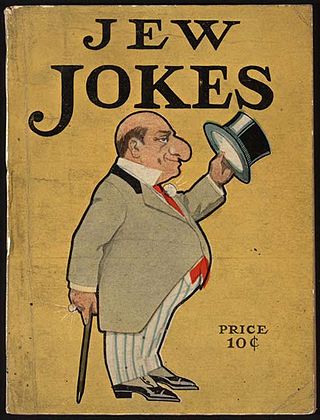
An ethnic joke is a remark aiming at humor relating to an ethnic, racial or cultural group, often referring to an ethnic stereotype of the group in question for its punchline.
The Poles come from different West Slavic tribes living on territories belonging later to Poland in the early Middle Ages.

The history of Poland from 1939 to 1945 encompasses primarily the period from the invasion of Poland by Nazi Germany and the Soviet Union to the end of World War II. Following the German–Soviet non-aggression pact, Poland was invaded by Nazi Germany on 1 September 1939 and by the Soviet Union on 17 September. The campaigns ended in early October with Germany and the Soviet Union dividing and annexing the whole of Poland. After the Axis attack on the Soviet Union in the summer of 1941, the entirety of Poland was occupied by Germany, which proceeded to advance its racial and genocidal policies across Poland.
The Polish American Congress (PAC) is an American umbrella organization of Polish-Americans and Polish-American organizations. Its membership has individuals as well as fraternal, educational, veterans, religious, cultural, social, business, and political organizations.

Polonophobia, also referred to as anti-Polonism or anti-Polish sentiment are terms for negative attitudes, prejudices, and actions against Poles as an ethnic group, Poland as their country, and their culture. These include ethnic prejudice against Poles and persons of Polish descent, other forms of discrimination, and mistreatment of Poles and the Polish diaspora.

The AB-Aktion, was a second stage of the Nazi German campaign of violence during World War II aimed to eliminate the intellectuals and the upper classes of the Second Polish Republic across the territories slated for eventual annexation. Most of the killings were arranged in a form of forced disappearances from multiple cities and towns upon the German arrival. In the spring and summer of 1940, more than 30,000 Polish citizens were arrested by the Nazi authorities in German-occupied central Poland, the so-called General Government. About 7,000 of them including community leaders, professors, teachers and priests were subsequently massacred secretly at various locations including at the Palmiry forest complex near Palmiry. The others were sent to Nazi concentration camps.
Żydokomuna is an anti-communist and antisemitic canard, or a pejorative stereotype, suggesting that most Jews collaborated with the Soviet Union in importing communism into Poland, or that there was an exclusively Jewish conspiracy to do so. A Polish language term for "Jewish Bolshevism", or more literally "Jewish communism", Żydokomuna is related to the "Jewish world conspiracy" myth.
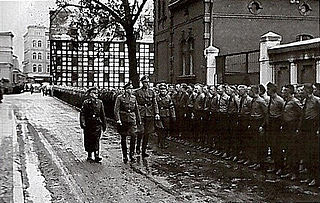
Selbstschutz is the name given to different iterations of ethnic-German self-protection units formed both after the First World War and in the lead-up to the Second World War.
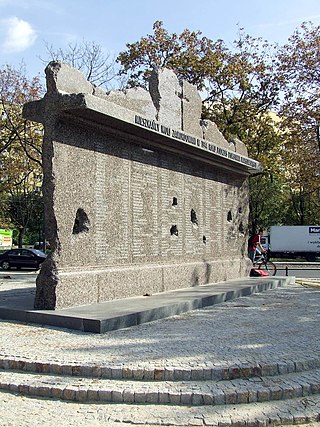
Crimes against the Polish nation committed by Nazi Germany and Axis collaborationist forces during the invasion of Poland, along with auxiliary battalions during the subsequent occupation of Poland in World War II, included the genocide of millions of Polish people, especially the systematic extermination of Jewish Poles. These mass killings were enacted by the Nazis with further plans that were justified by their racial theories, which regarded Poles and other Slavs, and especially Jews, as racially inferior Untermenschen.

Valley of Death in Fordon, Bydgoszcz, northern Poland, is a site of Nazi German mass murder committed at the beginning of World War II and a mass grave of 1,200–1,400 Poles and Jews murdered in October and November 1939 by the local German Selbstschutz and the Gestapo. The murders were a part of Intelligenzaktion in Pomerania, a Nazi action aimed at the elimination of the Polish intelligentsia in Reichsgau Danzig-West Prussia, which included the former Pomeranian Voivodeship. It was part of a larger genocidal action that took place in all German occupied Poland, code-named Operation Tannenberg.
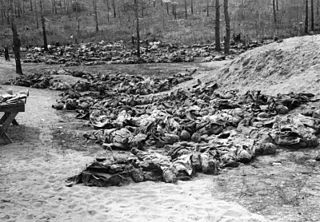
In the aftermath of the German and Soviet invasion of Poland, which took place in September 1939, the territory of Poland was divided in half between Nazi Germany and the Soviet Union. The Soviets had ceased to recognise the Polish state at the start of the invasion. Since 1939 German and Soviet officials coordinated their Poland-related policies and repressive actions. For nearly two years following the invasion, the two occupiers continued to discuss bilateral plans for dealing with the Polish resistance during Gestapo-NKVD Conferences until Germany's Operation Barbarossa against the Soviet Union, in June 1941.

The bilateral relations between Poland and Germany have been marked by an extensive and complicated history.
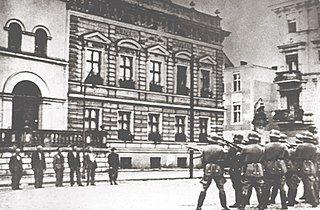
The Intelligenzaktion, or the Intelligentsia mass shootings, was a series of mass murders which was committed against the Polish intelligentsia early in the Second World War (1939–45) by Nazi Germany. The Germans conducted the operations in accordance with their plan to Germanize the western regions of occupied Poland, before their territorial annexation to the German Reich.

The Intelligenzaktion Pommern was a Nazi German operation aimed at the eradication of the Polish intelligentsia in Pomeranian Voivodeship and the surrounding areas at the beginning of World War II. It was part of a larger genocidal Intelligenzaktion that took place across most of Nazi-occupied western Poland in the course of Operation Tannenberg, purposed to install Nazi officials from SiPo, Kripo, Gestapo and SD at the helm of a new administrative machine.
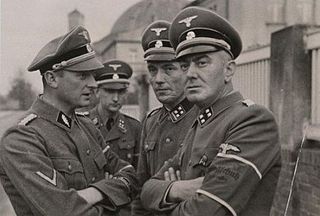
The Volksdeutscher Selbstschutz was an ethnic German self-protection militia, a paramilitary organization consisting of ethnic German (Volksdeutsche) mobilized from among the German minority in Poland. The Volksdeutscher Selbstschutz operated before, and during the opening stages of, World War II in the western half of Poland and were responsible for, and took part in, massacres of Poles, along with SS Einsatzgruppen. Selbstschutz counted circa 100,000 members, who formed greater part of German minority members "fit for action".
Racism in Poland in the 20th and 21st centuries has been a subject of extensive study. Ethnic minorities made up a greater proportion of the country's population from the founding of the Polish state through the Second Polish Republic than in the 21st century, when government statistics show 94% or more of the population self-reporting as ethnically Polish.

Around 6 million Polish citizens perished during World War II: about one fifth of the pre-war population. Most were civilian victims of the war crimes and crimes against humanity during the occupation by Nazi Germany and the Soviet Union. Approximately half were Polish Jews killed in The Holocaust. Statistics for Polish World War II casualties are divergent and contradictory. This article provides a summarization of these estimates of Poland's human losses in the war and their causes.

The occupation of Poland by Nazi Germany and the Soviet Union during World War II (1939–1945) began with the German-Soviet invasion of Poland in September 1939, and it was formally concluded with the defeat of Germany by the Allies in May 1945. Throughout the entire course of the occupation, the territory of Poland was divided between Nazi Germany and the Soviet Union (USSR), both of which intended to eradicate Poland's culture and subjugate its people. In the summer-autumn of 1941, the lands which were annexed by the Soviets were overrun by Germany in the course of the initially successful German attack on the USSR. After a few years of fighting, the Red Army drove the German forces out of the USSR and crossed into Poland from the rest of Central and Eastern Europe.
In the contemporary English language, the noun Polack is a derogatory, mainly North American, reference to a person of Polish origin. It is an anglicisation of the Polish masculine noun Polak, which denotes a person of Polish ethnicity and typically male gender. However, the English loanword is considered an ethnic slur.















